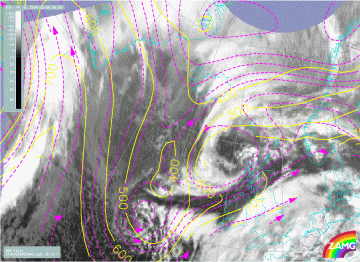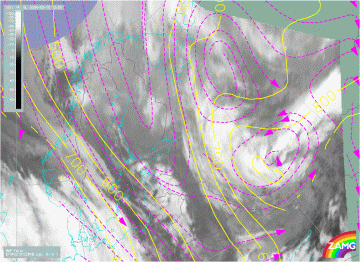Meteorological Physical Background
Different types of formation could be observed:
- North of an Occlusion another frontal system is passing by and a zone of confluence is developing
- Associated with Rapid Cyclogenesis (or Cold Conveyor Belt Occlusion): double structure at cloud spiral becoming detached
First Type
|
12 December 2003/00.00 UTC - Meteosat IR image
|
15 January 2009/00.00 UTC - Meteosat 9 IR 10.8 image and surface wind vectors
|
When looking at wind fields, both confluence and convergence where studied. Confluence is seen directly from the wind vectors when the direction of two neighbouring vectors are orientated towards each other, e.g. two air flows are coming together. On the other side convergence as a numerical parameter takes wind direction (confluence) as well as wind speed into account (see Basic chapter - Divergence for more details). In some cases where confluence can be observed, no convergence is found. In this study the contribution of confluence seems to be very important.
The Convergence Cloud develops in area of confluence of a stream from the north and a stream from the south where the confluence can seen best near the surface. The southerly flow is caused by the rotation of the Occlusion round the surface depression whereas the northerly results from the other system passing by. As a result of these two wind regimes interaction convergence is seen near the surface. A secondary convergence maximum is situated at higher levels, varying from case to case, both in level and in intensity. The relationship of cloud top height with convergence was investigated. It was found that Convergence Cloudiness shows as higher cloudiness if there is a thick layer of upper tropospheric convergence OR if the convergence in low levels is very distinct. Both convergence maxima conribute to the development of cloudiness.
Second Type
|
20 December 2008/06.00 UTC - Meteosat 9 IR10.8 image
|
20 December 2008/18.00 UTC - Meteosat 9 IR10.8 image
|
The Convergence Cloudiness develops in an area of confluence of the stream from the north and the stream from the south. Deformation, as well as vorticity associated with Occlusion, can clearly be seen. Convergence is found from the surface up to 700 hPa.
|
20 December 2008/18.00 UTC - Meteosat 9 IR10.8 image; magenta: wind (blue) and isotachs (red) 1000 hPa
|
20 December 2008/18.00 UTC - Meteosat 9 IR10.8 image; cyan: wind 850 hPa
|
|
20 December 2008/18.00 UTC - Meteosat 9 IR10.8 image; magenta: wind 500 hPa
|
|
For a different case the relative streams were investigated. It was found that the area of Convergence Cloudiness shows a significantly slower system velocity than the whole Occlusion. This can be interpreted as an indication that the convergence cloudiness can be regarded as a separate system in calculating relative streams. If only the convergence cloudiness is taken into account, the relative streams show following pattern in the majority of cases:
- The Convergence Cloud has a different velocity which is an indication that it should be treated as a separate CM. In most cases the displacement is less than that of the whole cloud spiral
- In the majority of cases an isolated cyclonic circulation could be found
- This circulation is more pronounced at upper levels
- The convergence cloudiness lies within (slight) upward motion
|
|
19 March 2004/12.00 UTC - Meteosat IR image; magenta: relative streams 298K, yellow: isobars 298K
|
|
06 February 2004/12.00 UTC - Meteosat IR image; magenta: relative streams 294K, yellow: isobars 294K
|
06 February 2004/06.00 UTC - Meteosat IR image; magenta: relative streams 298K, yellow: isobars 298K
|
Some cases do not show this pattern - then the convergence cloudiness lies within the upward (cyclonic) motion of the Occlusion stream lines.
|
10 February 2004/12.00 UTC - Meteosat IR image; magenta: relative streams 284K, yellow: isobars 284K
|
10 February 2004/12.00 UTC - Meteosat IR image; magenta: relative streams 288K, yellow: isobars 288K
|
The above mentioned findings are valid if the Convergence Cloudiness is treated separately. If the Occlusion cloud spiral or even the whole frontal system is used to calculate relative streams, this pattern vanishes. Upward motion can still be seen but there is no separate circulation.
Is Convergence Cloudiness a special type of Warm Front?
Indeed, there are many common features between Warm Fronts and this type of Convergence Cloudiness, as seen in numerical parameter fields and satellite imagery. The main difference is the formation: According to the polar front theory a baroclinic zone at the transition between warmer and colder air masses forms a Wave which then leads to cyclogenesis. The Occlusion develops after the Warm Front. In the case of the Convergence Cloudiness the Occlusion cloud spiral is already well developed and then the convergence shield forms.
Open questions
It is not possible to forecast whether Convergence Cloudiness will develop at the end of an Occlusion spiral or not. There are some indications that it occurs when another system passes nearby, but the processes are not yet fully understood.















